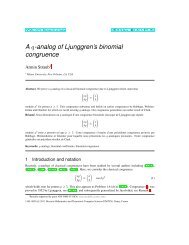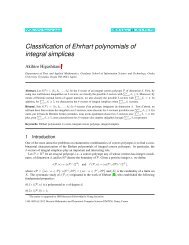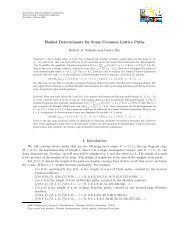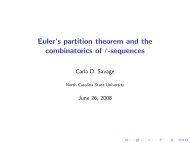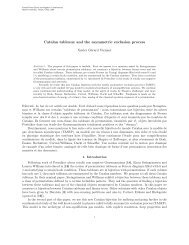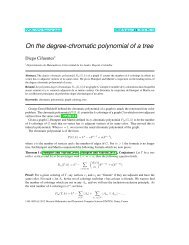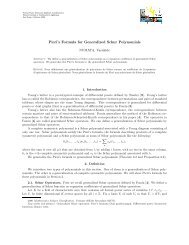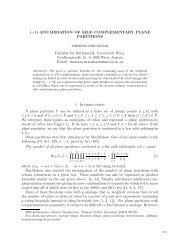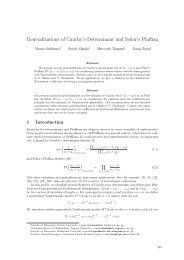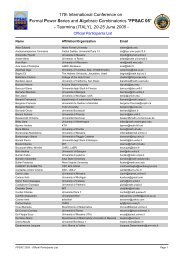Cartan invariant matrices for finite monoids - Nagoya University
Cartan invariant matrices for finite monoids - Nagoya University
Cartan invariant matrices for finite monoids - Nagoya University
You also want an ePaper? Increase the reach of your titles
YUMPU automatically turns print PDFs into web optimized ePapers that Google loves.
906 Nicolas M. Thiéry<br />
5 Special cases<br />
5.1 Aperiodic <strong>monoids</strong><br />
Proposition 5.1 Let M be an aperiodic monoid, and K be any field. One may take a concrete character<br />
such that the character table is integer valued and uni-triangular. In particular, the (p i ) i <strong>for</strong>m a Z basis<br />
of the Grothendieck group G 0 (KM).<br />
Let I be the indexing set of all J -classes, regular or not. Let<br />
T L := (χ Li (g j )) i∈I,j∈I<br />
and T R := (χ Ri (g j )) i∈I,j∈I<br />
be the (rectangular) <strong>matrices</strong> of the characters of the left class modules KL i and right class modules<br />
KR i respectively. Note that M act on those modules by trans<strong>for</strong>mation on the basis, so T L and T R<br />
are combinatorial and do not depend on the characteristic. Note that the matrix D L := T L T −1 is the<br />
decomposition matrix of the left class modules in term of the simple modules, and similarly <strong>for</strong> D R . As<br />
an essentially straight<strong>for</strong>ward corollary of Theorem 4.4, one gets:<br />
Theorem 5.2 The <strong>Cartan</strong> matrix of M is given by:<br />
C = t D L D R = t T −1t T L T R T −1 .<br />
Remark 5.3 Restricting T L to the regular J -classes, gives a unitriangular matrix. It follows that the<br />
character of the left classes provide yet another alternative basis <strong>for</strong> the Grothendieck group G 0 (KM),<br />
and similarly <strong>for</strong> the right classes.<br />
Hence, the theory is characteristic free <strong>for</strong> aperiodic <strong>monoids</strong>, and could be generalized straight<strong>for</strong>wardly<br />
to, say, principal ideal domains like Z. Altogether, all the ingredients are combinatorial, except <strong>for</strong><br />
the construction of the simple modules as top of the left class modules (the radical is obtained by solving<br />
a linear system), and computation of the character of the g i thereupon; because of that, the character table<br />
still depends on the characteristic.<br />
5.2 J -trivial <strong>monoids</strong><br />
We recover directly the description of the <strong>Cartan</strong> matrix of a J -trivial monoid M of [DHST11], without<br />
the need <strong>for</strong> orthogonal idempotents. The simple modules are in one-to-one correspondence with the<br />
idempotents of M, so we use I = E(M) as indexing set. For x ∈ M, define<br />
rfix(x) := min{e ∈ E(M) | xe = x} and lfix(x) := min{e ∈ E(M) | ex = x} ,<br />
where the min’s are taken in J -order (see [DHST11] <strong>for</strong> the details).<br />
Theorem 5.4 Let K be any field and M be a J -trivial monoid. Then, the <strong>Cartan</strong> matrix of KM is given<br />
by:<br />
χ KM = ∑ s lfix(x) ⊗ s ∗ rfix(x) .<br />
x∈M<br />
Proof: By Theorem 5.2, one is reduced to the calculation of the M-mod-M character of all J -class<br />
modules. Each such module is of the <strong>for</strong>m Kx <strong>for</strong> x in M; it is of dimension 1, simple, and isomorphic<br />
as a M-mod-M bimodule to S lfix(x) ⊗ Srfix(x) ∗ .<br />
✷



